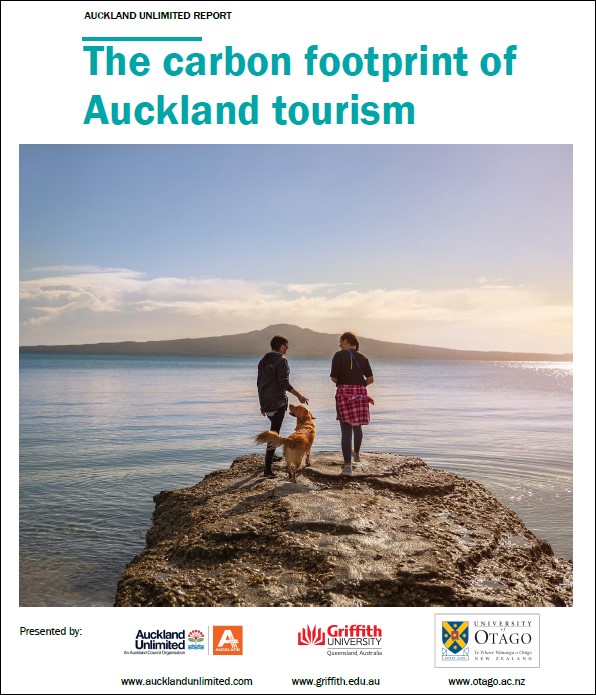The carbon footprint of Auckland tourism
Author:
Susanne Becken, James Higham, Griffith University, University of OtagoSource:
Auckland UnlimitedPublication date:
2021Topics:
EnvironmentExecutive Summary
Auckland is committed to ambitious actions to reduce emissions and prepare for the impacts of climate change. At the same time, the city experienced a fast-growing tourism sector, and it is expected that tourism continues to form an integral part of the Auckland economy after COVID-19. Decarbonising tourism is a critical element of future-proofing the sector. The first step in achieving this is to systematically measure the carbon footprint. Understanding tourism’s greenhouse gas emissions profile will inform Auckland’s tourism planning and management.
Building on the academic literature on carbon footprinting in tourism, two methods were applied. One draws on the top-down approach using national and regional statistics provided by Stats NZ. This method focused on three relevant industry groupings, namely: ‘Accommodation, food, and arts and recreation’, ‘Transport’, and ‘Tourism related industries’. Since this is a production-focused approach, only those emissions that are directly associated with businesses/industry are included. Fuel consumed by visitors in their rented or personal vehicles is not included. Furthermore, emissions associated with electricity generation are not included as these represent an indirect input into a tourism business.
The other method involved a bottom-up approach focused on accommodation, local transport and attractions. The calculations follow the logic of:
Carbon footprint = volume of tourists * activity volumes * carbon intensity
For example, the emissions associated with hotels would be derived by identifying the total number of tourists who stayed at a hotel, multiplied with the number of nights spent on average and the carbon emissions per guest night. As is explained in detail in the methodology section, it is difficult to compare these two approaches due to their different approaches and scopes.
In addition, and to complement the two destination-focused methods, it was deemed important to estimate the carbon emissions associated with travel to Auckland (international aviation, domestic travel and cruise ships). Whilst some methods of destination footprinting take a strictly territorial (geographic) approach, it is increasingly recommended as good practice that a destination considers the climate impact of transport emissions resulting from tourists getting to their place of visitation. These may count as indirect emissions, but are still an important element of a destination’s carbon risk and liability.
The results of the top-down method provided a timeline of carbon emissions, indicating an increase since 2014 – explained by the growth of the sector. In 2018, total emissions attributed to tourism reached 1,190 kilo-tonnes of CO2-e. Transport related to tourism industries was the largest contributor to emissions at 76.9%, whereby a significant part related to domestic air travel from Auckland. Accommodation contributed 16.9% of the total tourism footprint. Other tourism-related industries only made up 6.2% of emissions. Tourism’s share of emissions in Auckland was 11.7%.
The bottom up account of emissions resulting from Auckland accommodation (including staying with friends/relatives), attractions, and local transport results in 216 kilo-tonnes of CO2-e emissions. This is a conservative estimate due to the narrow scope. Again, transport was the largest contributor. This means that low carbon transitions are required for transport corridors to popular attractions, both within Central Auckland and to regions. In terms of accommodation, the relative importance of emissions associated with visitors staying in private houses was apparent. A regional analysis of activity patterns was attempted, but more refined data are required for improved analysis.
By far the largest contributor to climate change is international air travel by international visitors to Auckland with 3,513 kilo-tonnes of CO2-e. Domestic visitors and their associated (domestic) air travel, car and ferry emissions added 236 kilo-tonnes, and cruise ship passengers emitted 24 kilo-tonnes (with a high level of uncertainty). However, allocating cruise emissions to specific ports of visit is fraught with difficulty. The findings outlined in this report can be easily misinterpreted. Cruise justifies a depth of analysis that lies beyond the limitations of this report.
This inaugural work on the carbon footprint of tourism in Auckland provides a first baseline, but more work is required to refine the analysis. Several areas for improving the data availability and quality were identified. In the meantime, however, this analysis revealed that tourism is a significant contributor to emissions, and within that transport deserves particular attention. Moreover, non-transport emissions also add substantially to the tourism footprint.
Key recommendations are made for decision-making in the areas of tourism (and other) policy, product development, marketing and, data and research. It is suggested to conduct market analyses to inform a marketing optimisation strategy that is based on rigorous insights into the carbon implications of different visitor segments. Reporting and dissemination of information and advice are also important to further improve awareness and industry practice.
Auckland Unlimited, May 2021
